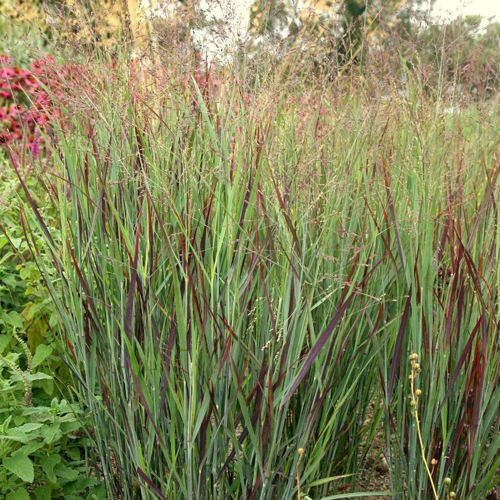Switchgrass (Panicum virgatum) in Grass New Hampshire
h4>Description:
- Appearance: Switchgrass is a tall, clump-forming grass that typically grows 3 to 6 feet tall, though some varieties can reach heights of up to 9 feet. It has fine-textured foliage and distinctive seed heads that emerge in late summer, turning a rusty orange color in the fall.
- Growth Habit: Switchgrass is a warm-season perennial grass with deep fibrous roots that can extend several feet into the soil. It forms dense clumps or stands, providing habitat and food for wildlife.
- Adaptability: Switchgrass is highly adaptable to a wide range of soil types and environmental conditions. It thrives in full sun but can tolerate partial shade and a variety of soil textures, from sandy to clayey. Switchgrass is drought-tolerant once established and can withstand occasional flooding.
h4>Description:
- Appearance: Switchgrass is a tall, clump-forming grass that typically grows 3 to 6 feet tall, though some varieties can reach heights of up to 9 feet. It has fine-textured foliage and distinctive seed heads that emerge in late summer, turning a rusty orange color in the fall.
- Growth Habit: Switchgrass is a warm-season perennial grass with deep fibrous roots that can extend several feet into the soil. It forms dense clumps or stands, providing habitat and food for wildlife.
- Adaptability: Switchgrass is highly adaptable to a wide range of soil types and environmental conditions. It thrives in full sun but can tolerate partial shade and a variety of soil textures, from sandy to clayey. Switchgrass is drought-tolerant once established and can withstand occasional flooding.
Description
Switchgrass (Panicum virgatum) is a warm-season, native grass that is widespread across North America. It is valued for its versatility, adaptability, and numerous ecological benefits. Switchgrass is commonly used for wildlife habitat, erosion control, biofuel production, and landscaping
h4>Description:
- Appearance: Switchgrass is a tall, clump-forming grass that typically grows 3 to 6 feet tall, though some varieties can reach heights of up to 9 feet. It has fine-textured foliage and distinctive seed heads that emerge in late summer, turning a rusty orange color in the fall.
- Growth Habit: Switchgrass is a warm-season perennial grass with deep fibrous roots that can extend several feet into the soil. It forms dense clumps or stands, providing habitat and food for wildlife.
- Adaptability: Switchgrass is highly adaptable to a wide range of soil types and environmental conditions. It thrives in full sun but can tolerate partial shade and a variety of soil textures, from sandy to clayey. Switchgrass is drought-tolerant once established and can withstand occasional flooding.
Planting Instructions:
- Timing: Plant Switchgrass seeds in late spring to early summer after the danger of frost has passed and soil temperatures consistently reach 60°F (15°C) or higher for optimal germination. Fall planting is also possible but may result in slower establishment.
- Site Selection: Choose a planting site with full sun exposure and well-drained soil. Switchgrass prefers soils with a pH between 5.5 and 7.5 but can tolerate a wide range of soil conditions. Avoid planting in low-lying areas prone to standing water.
- Seed Distribution: Prepare the planting area by removing weeds, rocks, and debris. Broadcast Switchgrass seeds evenly over the soil surface using a seed spreader or by hand. Aim for a seeding rate of 5 to 10 pounds per acre for native plantings or naturalized areas.
- Soil Preparation: Rake the seeds lightly into the soil to ensure good seed-to-soil contact, but avoid burying them too deeply. Switchgrass seeds require light to germinate, so a shallow planting depth of 1/8 to 1/4 inch is ideal.
- Watering: Water the seeded area lightly immediately after planting to moisten the soil. Keep the soil consistently moist but not waterlogged during the germination period, which typically takes 10 to 14 days. After germination, gradually reduce watering frequency to encourage deep root growth and drought tolerance.
- Maintenance: Once established, Switchgrass requires minimal maintenance. It is drought-tolerant and rarely requires supplemental irrigation except during prolonged dry spells. Mowing is generally not necessary, but periodic burning or cutting in late winter or early spring can help rejuvenate the stand and promote new growth.
- Wildlife Habitat: Switchgrass provides habitat and food for a variety of wildlife species, including songbirds, game birds, and small mammals. Leave some areas of the stand uncut to provide cover and nesting sites for wildlife.





